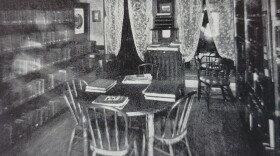During World War I there was a tremendous demand for grain to feed the armies fighting in the field. As prices rose, farmers in the Great Plains opened more land to cultivation. When the war ended, prices collapsed as demand for grain fell. Instead of reducing production, farmers opened more land thinking that they needed to sell more grain. The consequences were twofold. First, overproduction drove prices further down, which made agriculture the first business to enter the Great Depression. Second, opening so much farmland destroyed the native vegetation. It dried up the soil and helped create the Dust Bowl of the 1930s.
While Wisconsin and the Northwoods avoided the Dust Bowl, something similar did happen here. The solution for both the Great Plains and the Northwoods was the same. The similarity was logging. Logging companies clear cut forests without thought for the long-term consequences. Deforestation destroyed natural ecosystems, led to loss of habitat for animal species, and left the land vulnerable to high winds, drought, and wildfires.
The solution for both the Great Plains and Cutover was reforestation, starting with shelterbelts. In 1934, the Franklin Roosevelt Administration funded the planting of a series of 100-foot shelterbelts across the Great Plains states. A shelterbelt serves as a windbreak, helps hold in moisture, and stops soil erosion. The idea was effective, and by 1935 it was being implemented in farming regions of southern Wisconsin. The program proved so successful that it was soon extended across the entire state.
As progressive as this solution was, one Northwoods farmer had it all figured out long before the federal government got involved. Ralph Clark settled on his Lincoln County farm in 1904. The land he took was cutover, so he got to enjoy the laborious task of removing the stumps and other debris left behind by the logging companies. Even as Clark cleared the land and planned his farm buildings, he made an early decision to reserve a 10-acre tract west of his buildings where he would allow the pine forest to grow back.
Clark’s decision proved to be wise. Over the next 20 years the trees grew and provided not only a windbreak for his farm and buildings, but also served as a sanctuary for wildlife. In the early 1920s, a wildfire swept through the Clark farm and destroyed the family home and outbuildings. The 10-acre green forest shelterbelt survived and provided the lumber for the Clark family to rebuild.
By 1941, about 6 years into the federal government’s shelterbelt program, Clark’s 10 acres had been reduced to 8, but his shelterbelt that dated back to 1904 still served as an effective windbreak and provided the Clark family with fuel for heating and cooking. Lincoln County Agent Gus Sell used Clark’s woods as a living model of what a woodland shelterbelt could do. Clark also allowed CCC men from Camp Tomahawk to come to his woods and take low-value lumber for fuelwood.
The federal government’s shelterbelt program was the right idea, but if others had shared Clark’s foresight perhaps some of the Depression-era suffering could have been reduced.









